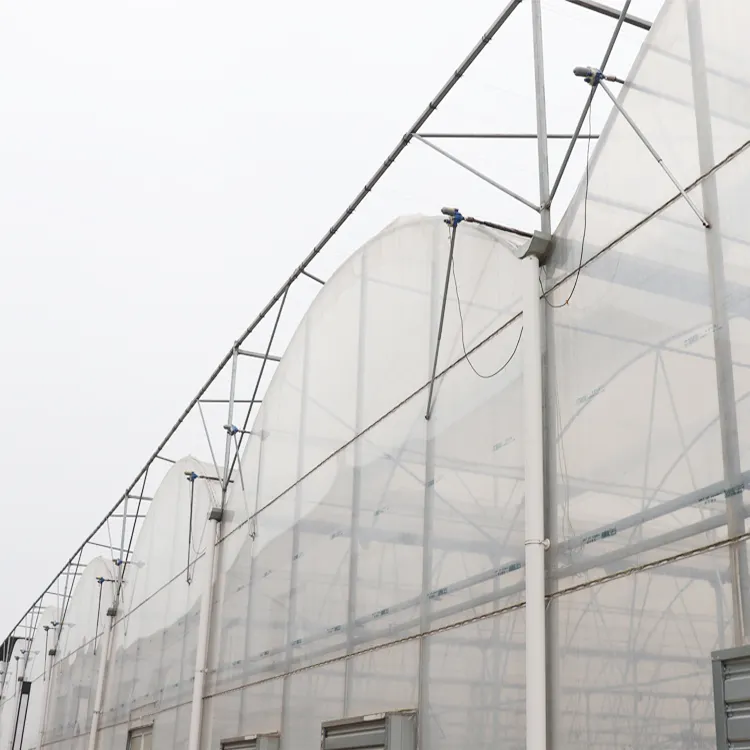A multi-span greenhouse, also known as a multispan greenhouse or multispan structure, is a type of greenhouse that consists of multiple connected spans or bays. It is characterized by having several separate sections or compartments within a single greenhouse structure. Each span is typically connected by a shared gutter system.
Here are some key features and characteristics of multi-span greenhouses:
- Structure: Multi-span greenhouses have a modular design with a series of connected spans. The structure is typically made of materials such as metal (aluminum or galvanized steel) or wood. The framework provides support for the glazing material and other components.
- Spans: The greenhouse is divided into multiple spans, which are individual sections or bays. Each span has its own roof and side walls, forming separate growing areas within the overall greenhouse structure.
- Gutter System: Multi-span greenhouses feature a gutter system that runs along the length of the spans. The gutters collect and channel rainwater and condensation to a drainage system or storage tanks. The gutter also helps to seal the junction between spans, preventing water leakage between sections.
- Ventilation: Multi-span greenhouses usually have ventilation systems that can be shared or individualized for each span. This allows for better control of airflow, temperature, and humidity within each section. Ventilation options include sidewall vents, ridge vents, louvers, or mechanical ventilation systems.
- Glazing: The glazing material used in multi-span greenhouses can vary based on the specific requirements and preferences of the grower. Common options include glass, polycarbonate, or greenhouse polyethylene film. The choice of glazing material affects factors such as light transmission, insulation, durability, and cost.
- Access and Pathways: Multi-span greenhouses typically have central pathways or aisles that run between the spans, allowing access for maintenance, harvesting, and other greenhouse operations. These pathways may be covered or uncovered, depending on the design and climate conditions.
- Size and Scalability: Multi-span greenhouses come in various sizes, ranging from small-scale structures to large commercial operations. The modular design allows for scalability, where additional spans can be added as needed to expand the growing area.
- Climate Control: Multi-span greenhouses offer better climate control compared to smaller or single-span structures. Each span can be individually managed, allowing customization of temperature, humidity, and other environmental factors based on the specific needs of the crops being grown.
Multi-span greenhouses are commonly used in commercial agriculture and horticulture operations. They provide a flexible and efficient growing space, allowing growers to separate different crops, implement various cultivation techniques, and optimize environmental conditions within each span. The modular design and scalability make multi-span greenhouses suitable for both small-scale and large-scale operations.
How does the gutter system in a multi-span greenhouse work to collect and channel water?
The gutter system in a multi-span greenhouse is an important component that collects and channels water, including rainwater and condensation, from each span to a central drainage system or storage tanks.
Here’s an overview of how the gutter system works:
- Gutter Placement: The gutter is positioned at the junction between adjacent spans, running along the length of the greenhouse. It is typically located at the lowest point of the roof slope, allowing water to flow towards it.
- Roof Pitch: The roof of each span is designed with a slight slope or pitch, directing water towards the gutter. The angle of the roof slope ensures that water flows naturally and does not accumulate on the roof surface.
- Gutters and Downspouts: The gutter itself is a trough or channel that collects the water running off the roof. It is often made of a durable material, such as PVC or aluminum, to withstand water flow and weather conditions. The gutter is connected to downspouts or vertical pipes that carry the collected water downwards.
- Spout Placement: Downspouts are strategically placed along the gutter system at regular intervals, typically positioned near the ends of each span. These spouts allow water to exit the gutter and flow downward towards the drainage system or storage tanks.
- Drainage System or Storage: The collected water from the downspouts is directed either into a drainage system, such as a network of pipes that leads to a designated drainage area, or into storage tanks for later use. The drainage system ensures that water is efficiently removed from the greenhouse, preventing waterlogging and potential damage to the structure or plants.
- Maintenance: Regular maintenance of the gutter system is important to ensure its proper functioning. This includes removing any debris, such as leaves or dirt, that may accumulate in the gutters or downspouts and cause blockages. Clearing the gutter system helps to maintain unobstructed water flow and prevents overflow or leakage.
The gutter system in a multi-span greenhouse plays a crucial role in managing water runoff and preventing excess moisture within the greenhouse structure. By effectively collecting and channeling water, it helps to maintain a controlled and healthy growing environment for the plants while preventing issues such as water damage, leakage, or structural instability.

